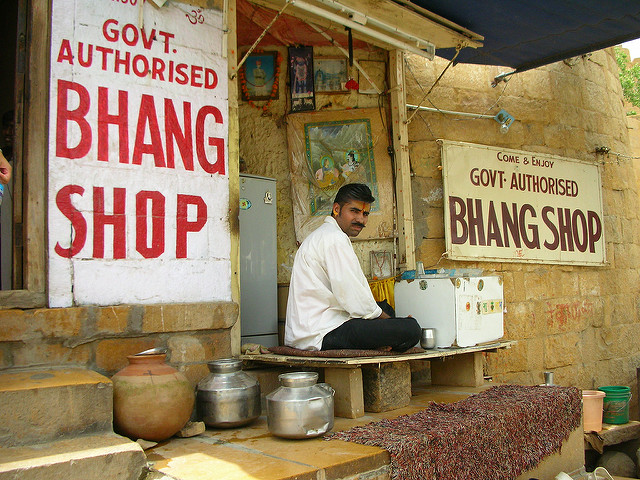*Editor’s Note: We don’t endorse this and we don’t endorse this and this is illegal but reading is legal and illegal things get legalized. ~ The Elephant Legal Team
For some, cannabis use is about more than promoting their health, it is a practice deeply tied to their beliefs.
It has nothing to do with getting high and having a good time; it is part of a spiritual practice no different from lighting candles, burning incense or placing holy water on our foreheads.
Bhang is a drink similar to a chai latte, but is infused with the leaves and tops of the cannabis plant, one of five sacred plants in Hindu culture. Drinking Bhang as part of the Festival of Holi or as part of meditation practice cleanses the body, clears the mind and unites one with the god Shiva. Cannabis as written about in scriptures, the Atharvaveda, is a plant that cleanses the body of maladies brought on by evil spirits. When Hindus consume it as part of a religious ceremony, it prepares them for well being in this life and the next.
However, it is not legal for Hindus in this country to engage in the religious practice of drinking bhang because cannabis is an illegal drug, with the exception of a few states where it is legal for recreational and/or medicinal use. It seems rather alarming when we consider that the Volstead Act, which made it illegal to consume alcohol in the United States, provided a limited exception for sacramental wine. So even in the days of Prohibition, people were allowed to consume wine for religious purposes.
Hinduism is now the fourth largest faith in the United States. Drinking bhang is so inextricably linked to the cultural and religious practices of Hinduism that prohibiting its use is a violation of the first amendment right to freedom of religion and freedom of expression. Bhang is an embodiment of the Hindu god, it is the giver of life, the source of happiness and opens the mind toward knowledge. It is no different than wine or other substances used to express our connection with a higher power. It is ironic that the Constitution, which was written on paper made from hemp (derived from the cannabis plant), expressly states that, “Congress shall make no law respecting the establishment of religion, or the free exercise thereof,” and at the same time there is a law prohibiting this freedom.
Over the last few years, people have tried to challenge the law banning the use of cannabis for religious purposes. To date, there have been a few cases in which religious exceptions for cannabis use were found legal. But for the most part, there is no consistent ruling. Case law varies from state to state.
People don’t really understand that this is not about the right to consume a drug or not, it is a human rights issue.
Hindus have been drinking bhang for centuries—they do so in happiness, and with joy. Such consumption is not threatening lives or creating violence, it is a celebration of life and happiness. It isn’t some loophole to get around the law, the government has not shown how consuming bhang during religious ceremonies is harmful to society.
If we can make exceptions for medical use, and we have made exceptions for the religious use of other previously illegal substances, bhang should be treated no differently.
Bhang Recipe
4 cups hemp milk
1 cup water
1/4 teaspoon freshly grated ginger
1 cinnamon stick
2 tablespoons blanched almonds
a dash nutmeg
a dash cardamom
a dash black pepper
1 small bud
Grate fresh ginger into hemp milk add a cinnamon stick and blanched almonds. Bring this to a gentle simmer. Remove stems from bud. Boil it in water for about 5 or 6 minutes. Dry the bud and wring out any excess water. With a mortar and pestle, grind a small bud of cannabis with nutmeg, cardamom and black pepper and a little of the hemp milk mixture. When fully ground add to the simmering hemp milk mixture. Strain and drink.
For those who have not consumed cannabis, drink slowly start with a quarter of a cup. Wait 30 to 40 minutes to feel how your body responds.
Author: Jane CoCo Cowles
Image: Tom Maisey/Flickr
Editor: Emily BArtran







Read 0 comments and reply